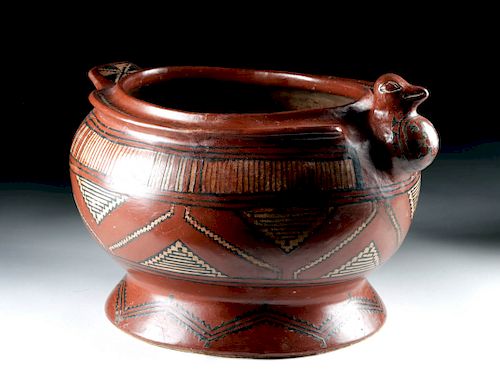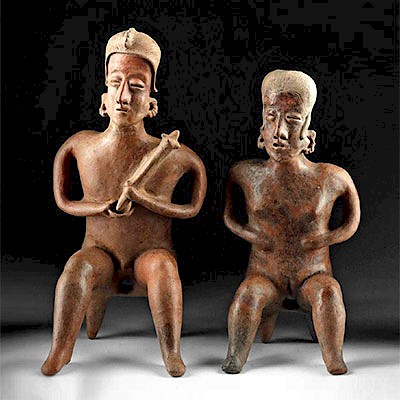Massive Chupicuaro Polychrome Vessel - Avian Effigy
Lot 128
About Seller
Artemis Gallery
686 S Taylor Ave, Ste 106
Louisville, CO 80027
United States
Selling antiquities, ancient and ethnographic art online since 1993, Artemis Gallery specializes in Classical Antiquities (Egyptian, Greek, Roman, Near Eastern), Asian, Pre-Columbian, African / Tribal / Oceanographic art. Our extensive inventory includes pottery, stone, metal, wood, glass and textil...Read more
Estimate:
$5,500 - $7,500
Absentee vs Live bid
Two ways to bid:
- Leave a max absentee bid and the platform will bid on your behalf up to your maximum bid during the live auction.
- Bid live during the auction and your bids will be submitted real-time to the auctioneer.
Bid Increments
| Price | Bid Increment |
|---|---|
| $0 | $25 |
| $300 | $50 |
| $1,000 | $100 |
| $2,000 | $250 |
| $5,000 | $500 |
| $10,000 | $1,000 |
| $20,000 | $2,500 |
| $50,000 | $5,000 |
| $100,000 | $10,000 |
| $200,000 | $20,000 |
About Auction
By Artemis Gallery
May 23, 2019
Set Reminder
2019-05-23 10:00:00
2019-05-23 10:00:00
America/New_York
Bidsquare
Bidsquare : Exceptional Day 2 Ethnographic Tribal Fossils
https://www.bidsquare.com/auctions/artemis-gallery/exceptional-day-2-ethnographic-tribal-fossils-4136
Day 2 of an important 2-day auction featuring exceptional ethnographic art from around the world. Today's sale will feature Pre-Columbian from the ancient americas, Native American, African / Tribal, Oceanic, Spanish Colonial, and incredible Fossils. Artemis Gallery info@artemisgallery.com
Day 2 of an important 2-day auction featuring exceptional ethnographic art from around the world. Today's sale will feature Pre-Columbian from the ancient americas, Native American, African / Tribal, Oceanic, Spanish Colonial, and incredible Fossils. Artemis Gallery info@artemisgallery.com
- Lot Description
Pre-Columbian, West Mexico, Guanajuato Valley, Chupicuaro, ca. 500 BCE to 300 CE. A striking pottery storage jar with a bulbous body with rounded walls, an overhanging lip, a pair of curved handles, a tab-shaped protrusions on the verso, and a bulbous decorative ornament on the front. The overall form of the vessel resembles a highly-stylized bird, with the handles doubling as wings and the tail on the back, the avian head boasting neatly-tooled facial features and a conical beak above a hemispherical chest decorated with an encircled checkerboard motif. The deep vermilion hue of the body serves as a wonderful ground atop which the cream and black-hued linear, geometric, stepped, and triangular details are presented, and the entire vessel rests atop a flared foot. A fabulous example replete with skillful execution and sophisticated motifs. Size: 11.5" W x 9.6" H (29.2 cm x 24.4 cm).
Chupicuaro society is well known for its sophisticated ceramic tradition featuring human effigies and food-service vessels of stunning aesthetic appeal such as this example. The feast was of utmost importance to supply food for the living as an integral part of social politics and also to provide sustenance for the soul's journey to the underworld. Beyond being objects for daily use, Chupicuaro ceramics were artistic achievements in their own right - elegant forms with boldly painted decoration typically in their signature deep red. The wide variety of vessel forms created by the Chupicuaro artisans points to the significance of the feast.
Provenance: ex-private Braunstein collection, Nevada, USA; ex-David Harner collection, acquired in the 1950s to 1960s
All items legal to buy/sell under U.S. Statute covering cultural patrimony Code 2600, CHAPTER 14, and are guaranteed to be as described or your money back.
A Certificate of Authenticity will accompany all winning bids.
We ship worldwide and handle all shipping in-house for your convenience.
#144458Professionally repaired from multiple large pieces, with restoration to some areas of foot and body, and resurfacing and overpainting along break lines and new material.Condition
- Shipping Info
-
All shipping is handled in-house for your convenience. Your invoice from Artemis Gallery will include shipping calculation instructions. If in doubt, please inquire BEFORE bidding for estimated shipping costs for individual items.
-
- Buyer's Premium



 EUR
EUR CAD
CAD AUD
AUD GBP
GBP MXN
MXN HKD
HKD CNY
CNY MYR
MYR SEK
SEK SGD
SGD CHF
CHF THB
THB
















